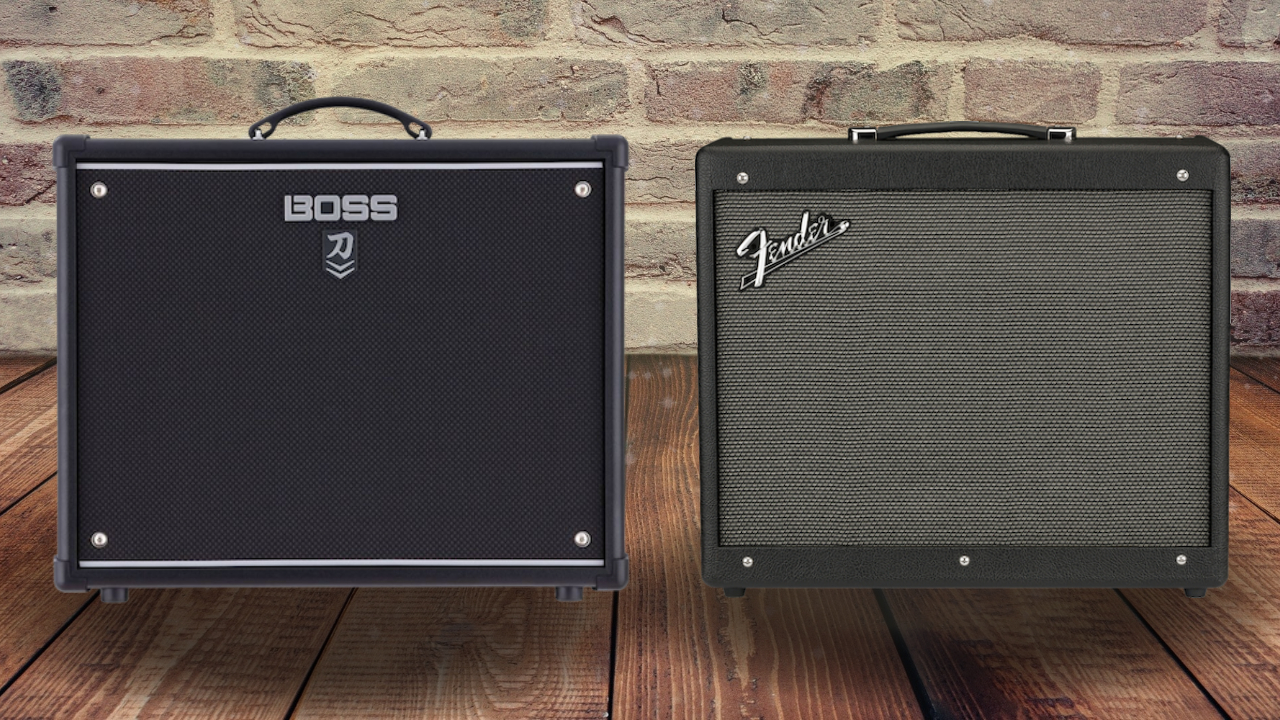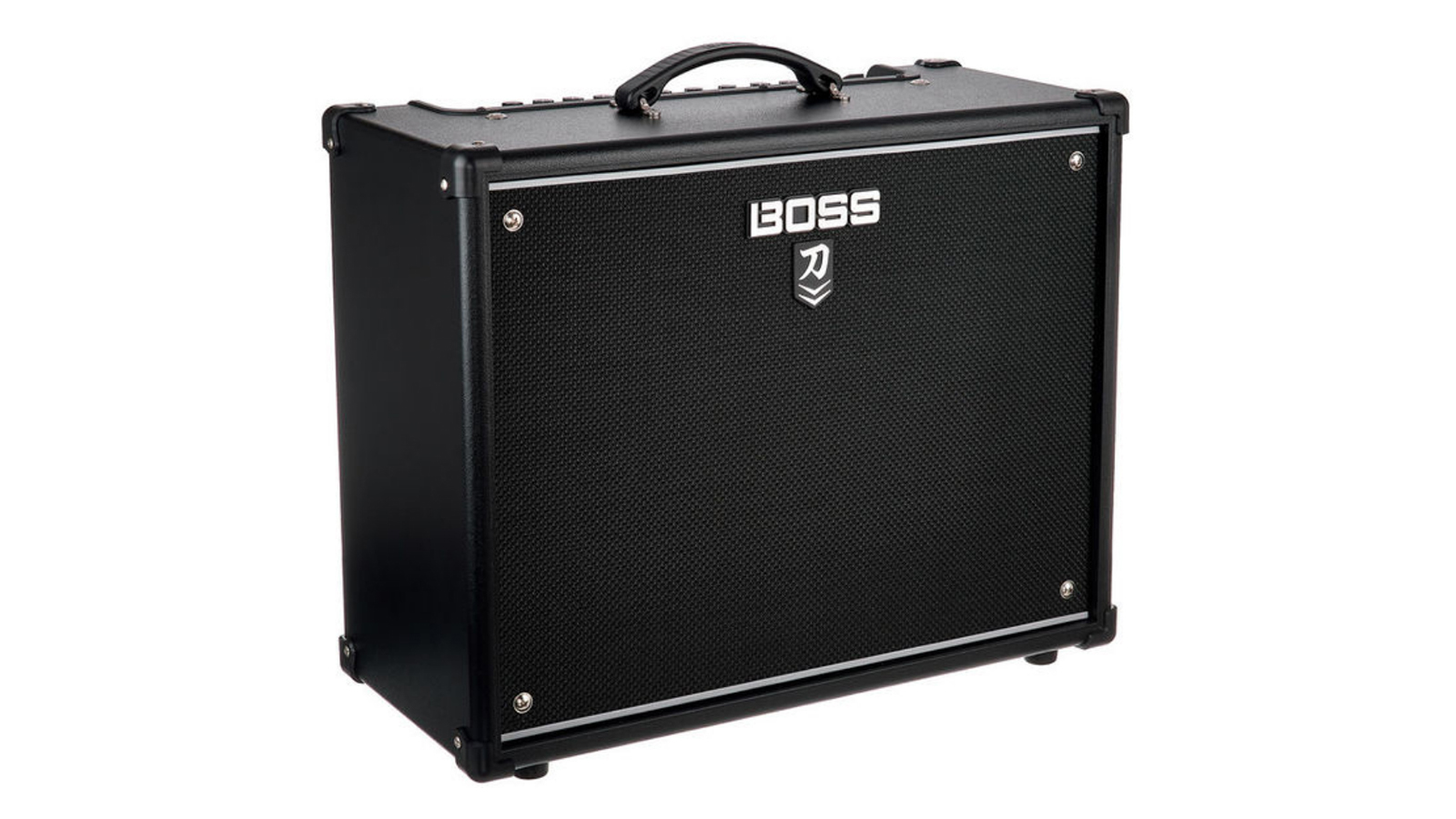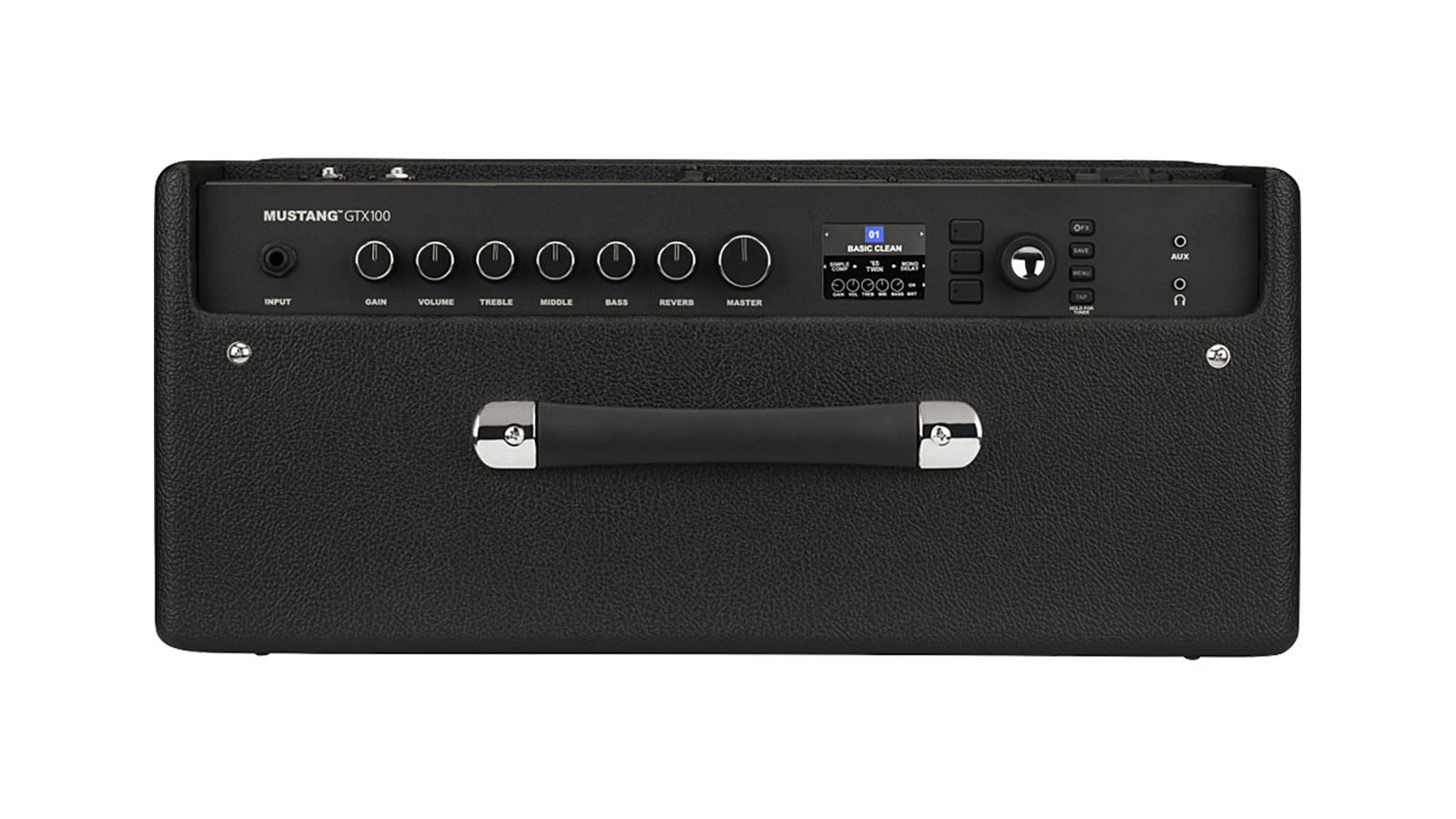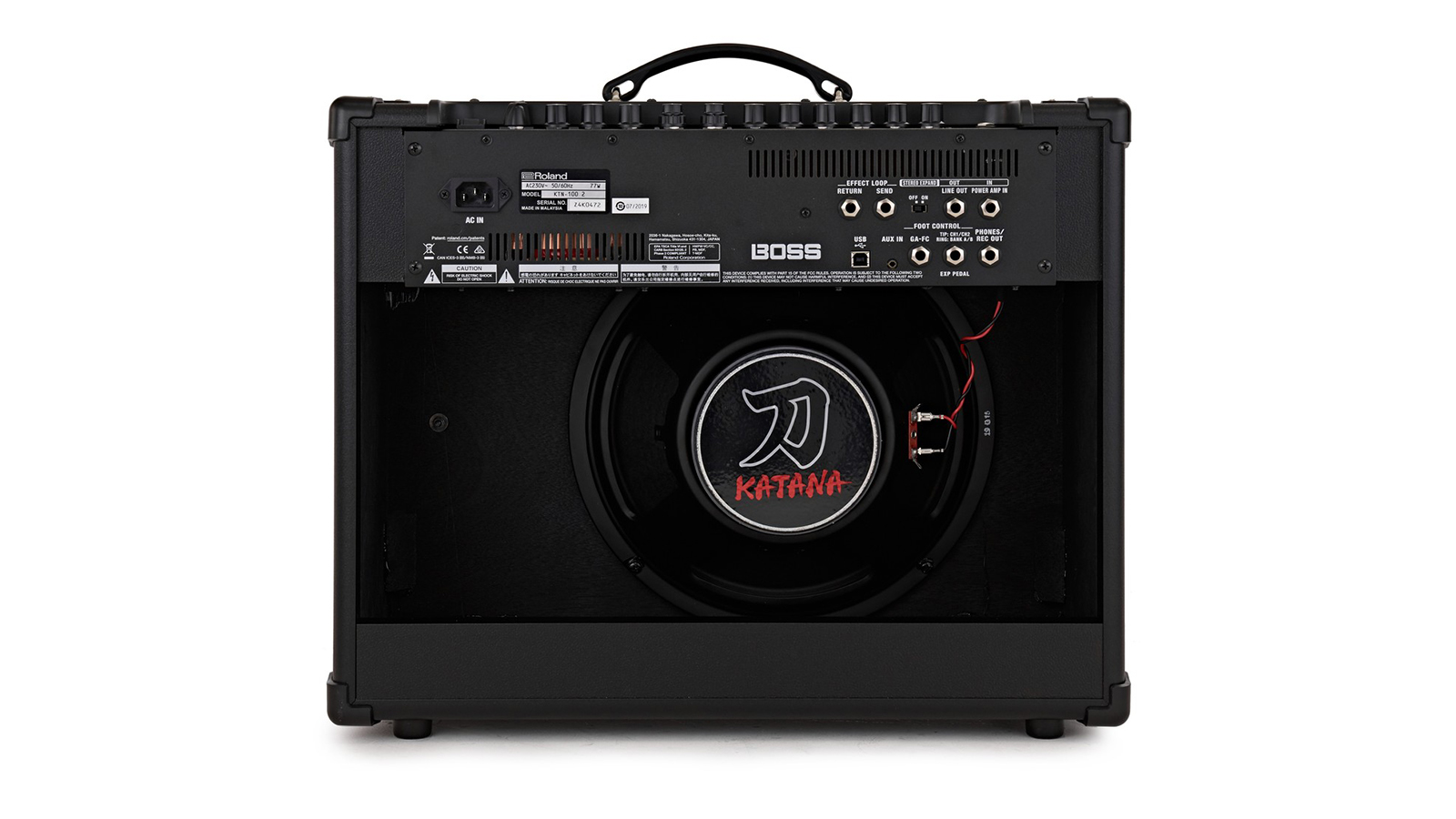Boss Katana vs Fender Mustang: which amp is right for you?
Two affordable modelling amps go head to head for tones, build, features and more

Modelling amps have come a long way since the Line 6 POD blew collective minds way back in 1996. Since then many have decried modelling amplifiers as inferior to their solid-state and tube counterparts, but that attitude has steadily changed as manufacturers have gotten better at imitating natural amp sounds digitally.
Both the Boss Katana Mk2 and the Fender Mustang GTX are at the forefront of the modelling amp category, providing guitarists with a wealth of tones and effects that sound phenomenal, all while costing less than half of their tube amp equivalents. These two modelling powerhouses pack a wealth of tones that will suit the palette of any player, encompassing everything from spanky cleans, to warm blues drive, all the way up to heavy metal distortion.
If you’ve been weighing up both amps but still can’t decide, we’re here to help settle the Boss Katana vs Fender Mustang score.
Boss Katana vs Fender Mustang: At a glance
The Boss Katana range features five amp models, each with its own variation taking you to a total of ten tonalities. Five independent effects sections offer further scope for tone tweaking, with Booster, Mod, FX, Delay, and Reverb essentially giving you a full pedalboard to go alongside your choice of amplifier. Three cabinet emulations make up the full complement of available tones, giving players an excellent variety.
The Fender Mustang ups the ante in terms of numbers, offering a whopping 40 amp models based on Fender favorites such as the ‘65 Deluxe Reverb, '57 Champ as well as great British amp simulations like the Marshall JCM 800 and the Vox AC30. It also packs a huge 75 effects settings with everything from Big Muff-style fuzz to TC Electronic inspired 2290 delays. All of this adds up to make the Mustang arguably one of the most flexible modelling amps on the planet.
For the purposes of this feature we’re going to focus specifically on the Boss Katana-100 Mk2 and the Fender Mustang GTX100, but both ranges also offer 50-watt versions.
Boss Katana 100 Mk2
- Boss Katana 100 Mk2 review
- Price: $399/£319
- Amps: Five unique amp characters (Clean, Crunch, Lead, Brown, and Acoustic), plus newly voiced variations for each
- Effects: Five independent effects sections (Booster, Mod, FX, Delay, and Reverb), with three selectable variations in each
- Other features: Eight Tone Setting memories for storing and recalling all amp and effect settings. Power Control for achieving cranked-amp tone and response at low volumes. Three Cab Resonance options (Vintage, Modern, and Deep), selectable in Boss Tone Studio
- Contact: Boss
Fender Mustang GTX100
- Fender Mustang GTX100 review
- Price: $499/£450
- Amps: 40 amp types with various vintage and modern classics from Fender and others
- Effects: 73 effects including multiple distortion, overdrive, compression, modulation, reverb, delay and octave
- Other features: 200 presets, includes upgraded seven-button footswitch with individual bank up and down functions and easy effects selection, plus a tap tempo and 60-second looper. Fender Tone 3.0 app for iOS/Android for deep editing and preset browsing
- Contact: Fender
Boss Katana vs Fender Mustang: Hardware & features
In terms of hardware, these amps are both very closely matched. Both feature a single 12” speaker delivering 100 watts of power, offering plenty of girth for loud practices and small gigs. The Boss amp has a Katana-branded speaker, whilst the Mustang offers a better-known name with its Celestion special design speaker. The Mustang also ships with a GTX-7 footswitch, whereas with the Katana you will need to fork out extra cash for its equivalent.
Get The Pick Newsletter
All the latest guitar news, interviews, lessons, reviews, deals and more, direct to your inbox!
The Mustang GTX offers a single input, whilst the Katana delivers more flexibility in that it gives you a dedicated Power Amp In for you to use your own preamp, modellers and multi-effects. Both give you an effects loop for running your own time-based effects, with the Boss Katana adding some extra functionality with a selectable parallel/series option.
Both amps offer various options for outputting your signal to sources, including all the usual suspects like a line out and USB out. However, the Fender Mustang also gives you stereo XLR and 1/4" outputs, making it easily interfaceable with mixing desks, PAs, and audio interfaces.
Winner: The Fender Mustang takes it for us here thanks to its included footswitch which delivers a lot of extra functionality, plus the slightly better output options.
Boss Katana vs Fender Mustang: Build quality & design

As you’d expect coming from two major musical instrument manufacturers, these are both high-quality feeling amps. All of the knobs and buttons are solid and there’s nothing flimsy at all about either of them. The Boss Katana is the heavier of the two thanks to its Class A/B power amp, but the Fender Mustang GTX is ever so slightly larger in terms of dimensions.
Looking at the aesthetic, these are both very similar looking amplifiers. The Boss Katana has an all-black appearance, much like the historical figure who wielded its namesake. The design is clean and sleek, but it doesn’t particularly stand out against other amplifiers in its class.
The Fender Mustang GTX on the other hand looks a little classier in comparison, with its grey grilled front and the classic shiny Fender logo subtly placed in the top corner. It looks like a Fender amp made for the modern era, retaining those classic aspects you’d expect of a Fender, with a color scheme that’s thoroughly modern.
Winner: It’s hard to find fault with either amp here so we’re calling it a draw. The Mustang GTX edges it slightly in the looks department, but the Katana feels more solid with a reassuring weight to it.
Boss Katana vs Fender Mustang: Playability

Being amps of the modelling variety, both sport more controls than your typical solid-state or tube amp. These amps are beset by the weight of their considerable feature set in that you’ll need to fine-tune them to get the sound you really want, so be prepared to tweak to find your perfect guitar tone.
The Boss Katana has a raft of controls on its panel, with Amp Types, an EQ section, Effects controls, and lastly the Tone Setting segment. It’s an exhaustive set of knobs that enable you to quickly and easily get up and running without any diving into menus. If you want to tweak settings in-depth, you will need to download the Boss Tone Studio software and hook up a laptop or computer via USB-B.
The Fender Mustang GTX on the other hand has a much simpler tactile control set with a classic EQ section, gain, reverb, and master volume controls. To get into the deeper editing you’ll need to use the rotary knob and buttons augmented by a simple LCD screen. You can also use the Fender Tone app on your phone with the amp’s built-in Bluetooth for a much easier way to fine-tune your settings. We found this much simpler than dealing with the slightly fiddly rotary knob and push-buttons.
Winner: There’s little to separate the two of these amps here. Both give you a raft of functionality at your fingertips and both require tone tweaking from the off.
Boss Katana vs Fender Mustang: Sounds

Each amp has its own strengths when it comes to sound quality, although both are very adept at playing a variety of roles. When choosing either of these amps you’re getting a workhorse that will manage a variety of styles with aplomb.
The Mustang GTX delivers a raft of different amp models, and it’s not just the Fender classics that are present here. Marshall, Orange, Hiwatt, Friedman and Vox amps all make an appearance, giving you plenty to play around with. As you’d expect from a Fender amp, the cleans are pristine with plenty of power and clarity but the higher gain amps come in surprisingly weighty too, and that’s before you add in any extra drive from the extensive pedal section.
The Katana also delivers a fantastic set of crisp and clear clean sounds, and the high gain sounds are super tight. In between, there’s a great offering of tube-style overdriven sounds that are very usable. Although it has slightly fewer voicings than the Mustang, it’s the stompboxes where this amp really shines, as you’d expect with Boss’ FX heritage. The effects are really quite good, further enhancing the tonal complexity of this great amplifier.
Winner: You guessed it, another draw. Both deliver a fantastic set of amp models and stompbox emulations.
Boss Katana vs Fender Mustang: Verdict
It’s certainly a tough decision to pick a winner here. These amps are competing for the same space in the market, aimed firmly at guitarists who need a lot of versatility and value for money. With little to differentiate them in terms of features, functionality, build quality, and sound, it’s the finer details that will win the amp modelling war.
The Fender Mustang has a lot more amp models to choose from (hence the higher cost), and the majority of them are stunningly recreated. Having your own suite of classic Fender amps makes for a very tempting offer indeed. But the Katana doesn’t hold back in this regard either. Despite offering less in terms of numbers, it still delivers pristine clean amp modelling coupled with some fantastic high gain sounds. It holds its own with poise, striking just as many right notes as the Fender even if it lacks slightly in the numbers department.
Both amps definitely benefit from the additional functionality of their dedicated footswitches, and although you might be initially disappointed that the Katana doesn’t come with one already bundled, by the time you’ve factored in the extra cost of the Mustang GTX they both still come up even.
As we’re unable to distinguish these amps even on the nitty-gritty, we have to concede that there’s just no separating this brilliant pair of modelling amps. You really can’t go wrong with either, but if you’re a lover of classic amps then Fender might suit you better, whereas the Katana’s slight tilt towards FX and more modern guitar sounds will be very pleasing for the contemporary guitar player.

Matt is a Junior Deals Writer here at Guitar World. He regularly tests and reviews music gear with a focus on guitars, amps, pedals, modelers, and pretty much anything else guitar-related. Matt worked in music retail for 5 years at Dawsons Music and Northwest Guitars and has written for various music sites including MusicRadar, Guitar Player, Guitar.com, Ultimate Guitar, and Thomann’s t.blog. A regularly gigging guitarist with over 20 years of experience playing live and writing and recording in bands, he's performed everything from jazz to djent, gigging all over the country in more dingy venues than you can shake a drop-tuned guitar at.










